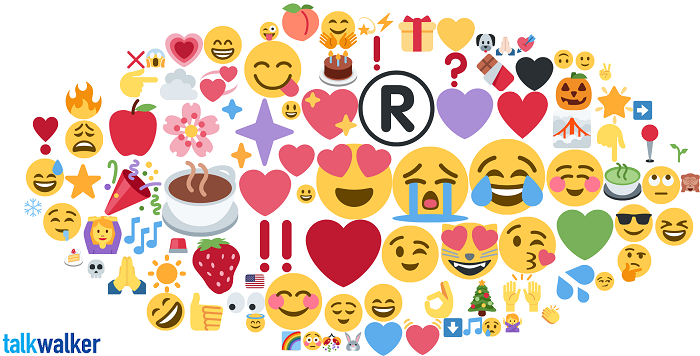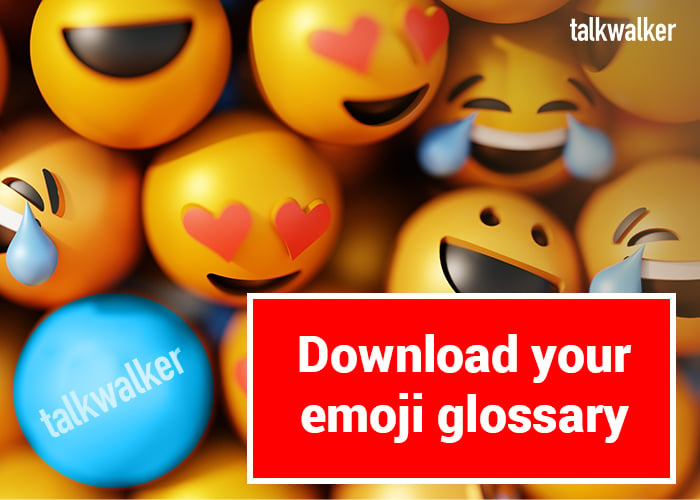Why you need to know your emoji meanings
Social is fast. And getting faster. And when you’re posting on the go, emoji are the modern shorthand.
Forget:-
I need coffee. My head hurts from all the partying last night.
And be more:-
=>☕️
So much quicker. No wonder they’re on the rise. (Crying Face) was used 2.6 billion times in the last year alone.
But what does all of this mean for your business? By using emoji analysis, you can translate this pictorial code into real brand insights. Discover new trends, track campaigns, build more comprehensive consumer profiles, understand brand sentiment, detect crises, engage with consumers and speak the same language!
They may be simple. But they can be mind-blowingly powerful for your social media analysis.
We’ve also gathered together some of the more obtuse emoji meanings in our glossary, to help you understand the hidden meanings. Download it below.
What are Starbucks’ emoji meanings?
Look at one specific case. Starbucks. Last year, they brewed over 4 billion cups of coffee. And had 11 million emoji used alongside brand mentions or detected alongside Starbucks’ logos, found using our image and video recognition.
That’s one for every 360 cups of coffee. And all of them can add to Starbucks’ understanding of their consumers. Helping them engage their audience better, boost their campaigns, and deal with product issues more effectively.
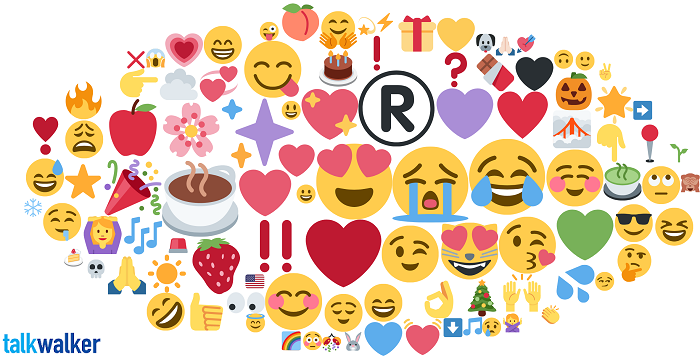
The top 100 emoji associated with Starbucks in the last 13 months.
Let’s take a look at their most popular emoji, and see if Starbucks should be (Smiley Face), (Angry Face), or (Disappointed But Relieved Face).
Make mine a Grande
Two emoji that jump out straight away are (Fog) and ☁ (Cloud). Not something you would expect from a coffee shop.
Step up, Ariana Grande.
She teamed up with Starbucks to launch their new Iced Cloud Macchiatos. But with her sponsored post, and Starbucks official post going live the same day, how can you tell which one gained the most impact for the brand?
Look at the emoji.
@Starbucks pic.twitter.com/msBHqmV9m4
— Ariana Grande (@ArianaGrande) March 5, 2019
Ariana used Fog in her promotion.
Introducing new Iced Cloud Macchiatos in Caramel and Cinnamon. So light and fluffy they’re basically a cloud in a cup. ☁️#CloudMacchiato
*Cloud foam contains egg whites pic.twitter.com/TyiAGKgGQO
— Starbucks Coffee (@Starbucks) March 5, 2019
While Starbucks used Clouds in theirs.
By comparing the 2 emojis, Starbucks can see how the two messages engaged differently. And which initial message sparked the mention: the influencer post or the organic post.
They both drove very similar mentions (34.4k for , 33k for ☁), but generated twice as much engagement. Ariana created more impact for this campaign.
The takeaway
If you want several influencers to share the same message, and want to monitor how they compare, try using different emoji. They’re easy to track across all your mentions.
The ingredients for customer insights
We all know consumer tastes change over time. But emoji can help you see how those customer taste buds are adapting.
By monitoring the emoji related to flavors, Starbucks can see which taste is hot, and which is leaving their consumers cold. Emoji analysis makes this easier to track on a large scale, as each flavor could relate to a variety of drinks. This lets us track the flavor, rather than the beverage.
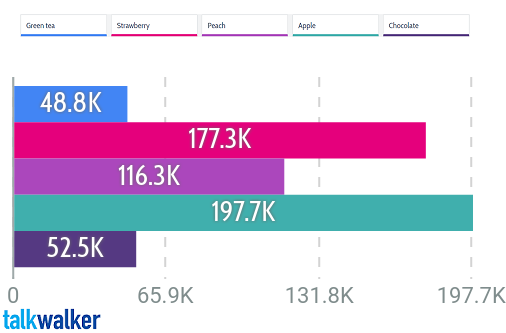
Comparing mentions of specific emoji alongside the Starbucks brand
At first, it seems (Apple) is the more popular flavor. But the vast majority of those mentions came from a product launch in October 2018 (171.1k), so that can be cut from the comparison.
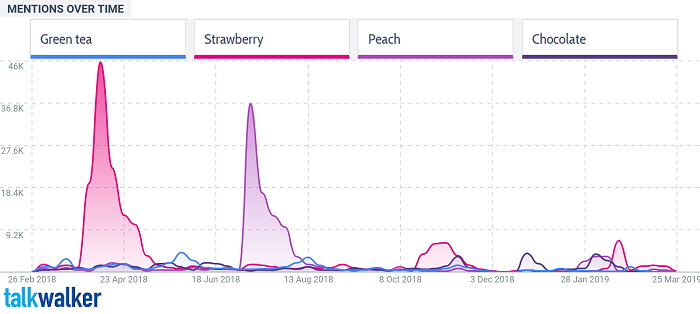
A look at how were mentioned alongside Starbucks in the last 13 months.
Although (Strawberry) peaked with a product launch in April 2018, it’s still consistently mentioned throughout the year, with several peaks late 2018, early 2019. If Starbucks wanted to add a new flavor to their menu, strawberry would be the way to go.
The takeaway
Use emoji to detect product preferences, so you can adapt to suit your client needs. Look at the most popular emoji meanings for your brand, and see how they are changing over time. It could inspire your next product launch.
It’s easy being green
It’s not just your own products that impact your business. You can also track global trends using emoji, and how they are impacting your client base.
Veganism and vegetarianism are becoming more popular on a global scale, driven by more socially conscious gen-Zs. And their associated emoji are on the increase too. (Green Heart) and (Seedling) are both used in relation to alternative diets, green issues, and healthy eating.
And since Starbucks are a major drinks supplier, they need to track how these emoji are being linked to their brand.
Mentions of in relation to Starbucks, have increased from 594 in March 2018, to 22.2k in March 2019. This is due to the brand engaging with their clients’ needs, and providing a range of products to suit all diets.
Breakfast on the go today ♀️while waiting for my #almond #latte I picked up this All Day #Vegan Breakfast Burrito @starbucksuk Smoked scrambled #tofu with #spinach & #mushrooms layered with tomatos & #chipotle beans wrapped in a spinach tortilla Nice one @starbucks pic.twitter.com/BRpCcHyOuJ
— Curious Vegans (@CuriousVegans) March 21, 2019
How to win over customers by supplying products to meet their needs.
They’re also considering green issues, tackling plastic waste by banning plastic straws by 2020.
The takeaway
Look at the major trends impacting your industry and see how they are appearing in your mentions. Is your audience crying out for you to take action on a social issue, or can you change your products to meet their needs? The emoji show you.
It’s a sad world
Emoji, combined with sentiment analysis, are also great ways to understand how you perceive your brand.
In the emoji cloud at the start of this post, the crying face was significant. But in this case, it isn’t negative. It’s actually showing when consumers are creating emotional engagement with the Starbucks brand.
By analyzing positive mentions of and Starbucks, we can find emotional consumer stories, of good deeds and kindness. These are fantastic for gathering audience engagement, and boosting brand sentiment.
All Starbucks has to do is find them and share them. Easy.
My dad knew I wasn’t having the best day & was upset so on his way home from work he stopped at Starbucks to surprise me & said idk how to order your fancy drink so I told them you usually get the cold coffee with the foam stuff on top and he is the cutest
— Mariah DelBianco (@m_delbs) February 28, 2019
helps highlight emotional consumer stories
You can also see the consumer touchpoints that are impacting your customer. (Face With Smiling Eyes) tends to show moments of satisfaction, and how Starbucks is a part of that. They’re not just providing drinks, but becoming a part of a happy lifestyle.
Taking some time out today to focus on me. Went for a lovely walk in the sunshine, booked my hair to get cut and coloured, did a little bit of shopping and now sat in Starbucks enjoying a soya hot chocolate. This is a good day #PMA
— Em (@_emgem91) February 23, 2019
While is more about contentment.
The takeaway
Look at the emotional emoji your consumers share with your brand, and see what conversations they’re driving. They can highlight anything from great customer service, to crisis issues. Look at the main emotional faces, like (Weary Face), (Tired Face), (Pouting Face), (Smiling Face With Open Mouth), or (Sleepy Face).
Make mine a catachino
Emoji are also perfect for flagging up unexpected conversations. Once you know your most common ones, it’s easy to spot the rogues. Allowing you to quickly dive deep into what caused the new conversation.
If we combine emoji analysis with our new video recognition tool, we can see the emoji that appear in videos that contain the Starbucks logo, but have no mention of the brand.
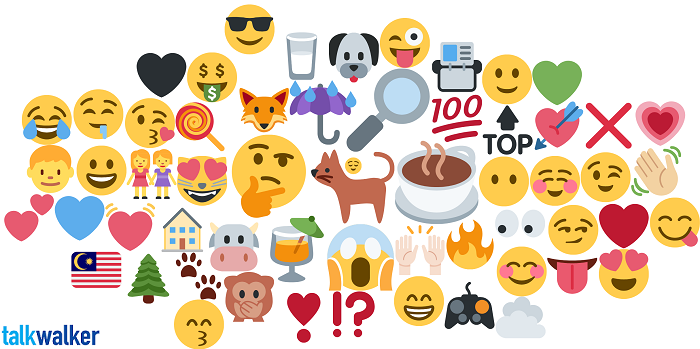
Why is that cat there?
That (Cat) jumps straight out. It’s not one that would commonly be used in relation to Starbucks, so you can instantly see that a new topic is trending.
A cat that liked “whisked” cream.
In this case, it’s more shareable content rather than a crisis, but the emoji highlighted this quickly as content outside the norm.
The takeaway
Know you brand emoji back to front, inside and out. And you can instantly see when a new topic is growing, even before your textual analytics detects it. Remember, this is the language your consumers speak. Know your emoji meanings!
Emoji analysis - Easy as
Emoji are more than just little unicode standard pics. They’re the shorthand solution to understanding your audience conversations.
So get out there, slip on your (Grinning Face) and (Bunny Ears), and start analyzing. Don’t forget to download your emoji glossary below, or feel free to leave your comments or questions at our ♂️ (Information Desk - or, well, the comments box below).

